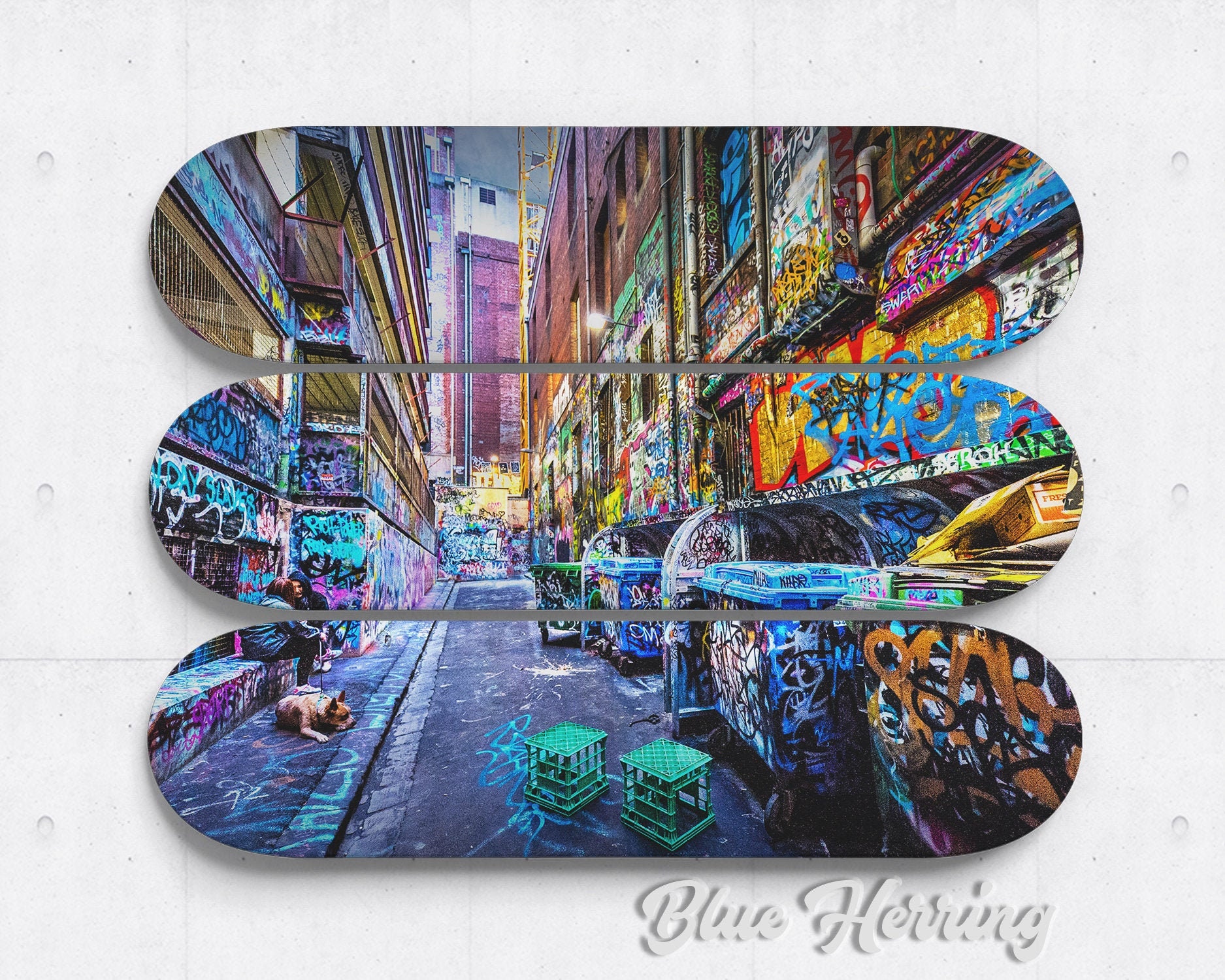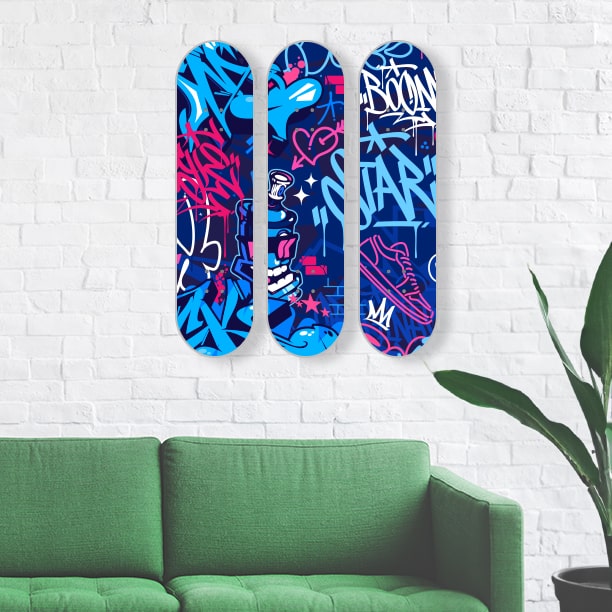So here's a question I get asked at least three times a week: "Where should I actually buy skateboard wall art?" And honestly, the answer isn't as simple as pointing someone to a single website and calling it a day.
I'm Stanislav, founder of DeckArts here in Berlin, and after four years running a specialty skateboard art business—plus my previous experience working with Ukrainian streetwear brands and organizing art events for Red Bull Ukraine—I've developed some pretty strong opinions about where people should (and shouldn't) shop for skateboard wall art.
The ecommerce landscape for art has changed dramatically. According to Artsy's Art Market Trends 2025 report, 59% of collectors purchased art online in 2024, with 73% of those saying they bought as much or more online compared to the previous year. That's a massive shift - and it means the platform you choose actually matters more than ever.
Let me break down the real differences between Amazon, Etsy, and specialty stores like DeckArts, based on what actually affects your buying experience: quality, pricing, authenticity, customer service, and whether you'll end up with something worth hanging on your wall.

Amazon: Mass Market Convenience vs Quality Concerns
Let me start with Amazon because, well, it's Amazon. The platform has over 300 million active customers globally, and Amazon Handmade (their artisan marketplace launched in 2015) tries to carve out space for handcrafted goods within that massive ecosystem.
The Amazon Advantage
Convenience is unbeatable. Prime shipping, easy returns, familiar checkout process - these things genuinely matter when you're buying something as large as a skateboard deck for your wall. According to Shopify's marketplace comparison, Amazon offers Fulfillment by Amazon (FBA), meaning sellers can warehouse products at Amazon facilities for faster shipping.
No listing fees. Unlike Etsy, Amazon Handmade doesn't charge sellers listing fees, which theoretically could translate to lower prices for buyers. You only pay when you buy.
Massive product selection. Because Amazon integrates handmade goods into its larger marketplace, you might stumble across skateboard wall art while browsing for completely unrelated items. Serendipitous discovery can be powerful.
The Amazon Problems
Here's where it gets tricky. Amazon charges sellers a 15% commission on every sale - more than double Etsy's 6.5%. That cost typically gets passed to buyers through higher prices or lower quality materials to maintain margins.
More importantly, quality control is inconsistent. I've seen "skateboard wall art" listings on Amazon that are literally just printed posters glued to particle board shaped like skateboards. No real maple deck, no authentic screen printing, just... stuff that looks vaguely skateboard-adjacent.
The lack of transparency is also a genuine issue. Artsy's research found that 69% of art collectors hesitated to buy art due to lack of transparency about provenance, materials, and authenticity. On Amazon, product descriptions are often sparse, photos can be misleading, and you're rarely buying directly from the person who created the piece.
And honestly? Amazon competes with its own sellers. The platform promotes its in-house brands alongside third-party vendors, so you're effectively competing for visibility with the world's largest ecommerce company.
Etsy: The Handmade Marketplace with Growing Pains
Etsy started in 2005 as a Brooklyn-based marketplace for handmade and vintage goods, and it's grown into a platform with nearly 90 million active buyers in 2024. It's where most people think to look first when they want something handmade.
The Etsy Strengths
Intentional buyers. Unlike Amazon, where people might accidentally find your product, Etsy shoppers are specifically looking for handmade, unique, or vintage items. That buyer intent is valuable - these aren't casual browsers, they're collectors.
Lower transaction fees. At 6.5% plus a 3% payment processing fee (for US sellers), Etsy's costs are substantially lower than Amazon's 15%. In theory, this should translate to better prices or higher quality for the same price point.
Storefront customization. The paid Etsy Plus plan ($10/month) lets sellers customize their shop appearance, add featured listings, and build brand identity. This matters more than you might think - a well-designed Etsy shop signals professionalism and attention to detail.
Community and discovery. Etsy's search algorithm favors unique, well-photographed items with detailed descriptions. If a seller puts in the effort, their work gets rewarded with visibility.

The Etsy Challenges
The biggest issue I see? Quality varies wildly. Etsy's low barrier to entry means anyone can set up a shop, and not everyone has the skills, materials, or ethics to deliver what they promise.
I've heard nightmare stories: customers ordering "handcrafted Renaissance skateboard art" only to receive mass-produced prints from AliExpress dropshippers. Etsy's gotten better at policing this, but the problem persists.
Recurring listing fees can be frustrating. At $0.20 per product every four months, these add up if you're browsing extensively or if sellers pass the cost to buyers. And unlike Amazon's Professional Plan (which becomes free after the first month), Etsy's fees never go away.
No fulfillment services. Etsy sellers handle all shipping logistics themselves. This can mean slower delivery, less professional packaging, and higher shipping costs compared to Amazon's streamlined FBA system.
And here's something that frustrates me personally: Etsy's brand has become so associated with "cheap handmade gifts" that serious art collectors sometimes dismiss the entire platform. That's unfair to the talented artisans there, but perception matters.
Specialty Stores: Curated Quality at a Premium
This is where businesses like DeckArts, The Skateroom, and other focused skateboard art companies come in. We're smaller, more specialized, and yes - typically more expensive. But there are the the genuine reasons why collectors increasingly choose specialty stores over mass marketplaces.
The Specialty Store Advantages
Curated quality standards. When you buy from a specialty store, someone has actually vetted the artwork, printing process, and materials. We're not just reselling random products - we're building a reputation on every piece that goes out.
At DeckArts, every Caravaggio Medusa skateboard deck uses premium Canadian maple, archival-quality inks, and UV-resistant coating. That's not marketing fluff - those specifications matter for longevity and color accuracy. When you order from us, you're getting museum-quality reproductions, not whatever was cheapest to print that week.
Transparent sourcing and authenticity. Specialty stores can (and should) tell you exactly where materials come from, how prints are made, and why specific artistic choices were made. That transparency addresses the exact concern that Artsy identified: only 17% of collectors believe the art market caters very well to them, largely due to opacity around pricing and provenance.
Expert curation and context. When I select pieces for our skateboard wall art collection, I'm drawing on years of art history knowledge and design experience. I can explain why Botticelli's Birth of Venus works better horizontally than vertically, or why certain Baroque paintings translate exceptionally well to skateboard format.
That expertise isn't available when you're scrolling through page 47 of Amazon search results.
Customer service and education. Specialty stores can offer installation guidance, styling advice, and detailed care instructions. We've written comprehensive guides on how to hang skateboard art using 7 different methods and the psychology of horizontal vs vertical mounting - content that actually helps customers make informed decisions.

The Specialty Store Trade-offs
Let's be honest: prices are higher. Our Bosch Garden of Earthly Delights triptych costs significantly more than a mass-produced skateboard print from Amazon. That premium reflects material quality, printing standards, and the expertise behind curation - but it's still more money upfront.
Smaller inventory selection. Where Amazon might have 10,000 skateboard-adjacent products and Etsy might have 50,000 listings, a specialty store like DeckArts might offer 50 carefully chosen pieces. If you want endless variety, we can't compete with marketplace scale.
Slower shipping in some cases. While we've optimized our fulfillment to be competitive, we can't match Amazon Prime's infrastructure. If you need something tomorrow, Amazon wins on logistics.
Less discovery serendipity. You have to intentionally find and visit specialty stores. Unlike marketplaces where algorithmic recommendations might surface unexpected finds, specialty stores require more deliberate exploration.
So Where Should You Actually Buy?
After breaking down all three options, here's my honest recommendation based on what you're looking for:
Choose Amazon if: You prioritize convenience and fast shipping above all else, you're okay with quality variability, and you want the safety net of Amazon's return policy. Best for casual buyers or gifts where authenticity isn't the primary concern.
Choose Etsy if: You want handmade uniqueness and enjoy the discovery process of browsing individual creator shops. You're willing to do research on seller reputations, read reviews carefully, and accept some shipping delays. Best for buyers who value the "handmade story" and supporting individual artisans.
Choose specialty stores if: Quality, authenticity, and expert curation matter more than saving $20-50. You want pieces that last decades, not years. You value transparent sourcing, educational content, and speaking with people who genuinely understand what they're selling. Best for serious collectors building intentional spaces.
Honestly, there's room for all three in the market. I've bought art supplies from Amazon, vintage skateboard memorabilia from Etsy, and obviously I run a specialty store myself. The key is matching the platform to your specific needs for that particular purchase.
For small spaces where every piece needs to work perfectly, our guide on maximizing visual impact in 200 square foot apartments can help you make the most informed choice regardless of where you shop.
The Future of Art E-commerce
One thing I'm certain about: the trend toward online art buying isn't reversing. With 43% of galleries planning to focus more on online sales according to Artsy's data, and collectors increasingly comfortable purchasing art without seeing it in person first, the platforms we choose will shape not just individual purchases, but the entire art market.
The platforms that win will be those that solve the transparency problem. Whether that's Amazon improving product information standards, Etsy cracking down harder on dropshippers, or specialty stores like us continuing to educate buyers about what quality actually means - transparency is everything.
From my experience both buying and selling art online over the past four years in Berlin, I've learned that the "best" platform depends entirely on your priorities. Just know what you're optimizing for, do your research, and don't assume higher price always means higher quality (or vice versa).
The skateboard wall art market is still young enough that dramatic improvements are possible across all platforms. Here's hoping they all evolve to serve collectors better.
Article Summary
This comprehensive comparison examines Amazon, Etsy, and specialty stores as sources for skateboard wall art in 2025, drawing from Artsy's Art Market Trends report showing 59% of collectors now buy art online and Shopify's marketplace analysis. We analyze each platform's strengths and weaknesses: Amazon's unbeatable convenience versus inconsistent quality (15% seller fees, FBA fulfillment), Etsy's handmade focus versus variable standards (6.5% fees, 90M active buyers), and specialty stores' curated quality versus higher prices. The article provides honest guidance on which platform suits different buyer priorities—casual convenience seekers, handmade enthusiasts, or serious collectors valuing authenticity and expertise—while addressing the transparency concerns that affect 69% of art buyers.
About the Author
Stanislav Arnautov is the founder of DeckArts and a creative director originally from Ukraine, now based in Berlin. With extensive experience in branding, merchandise design, and vector graphics, Stanislav has worked with Ukrainian streetwear brands and organized art events for Red Bull Ukraine. His unique expertise combines classical art knowledge with modern design sensibilities, creating museum-quality skateboard art that bridges Renaissance masterpieces with contemporary culture. Follow him on Instagram, visit his personal website stasarnautov.com, or check out DeckArts on Instagram and explore the curated collection at DeckArts.com.

